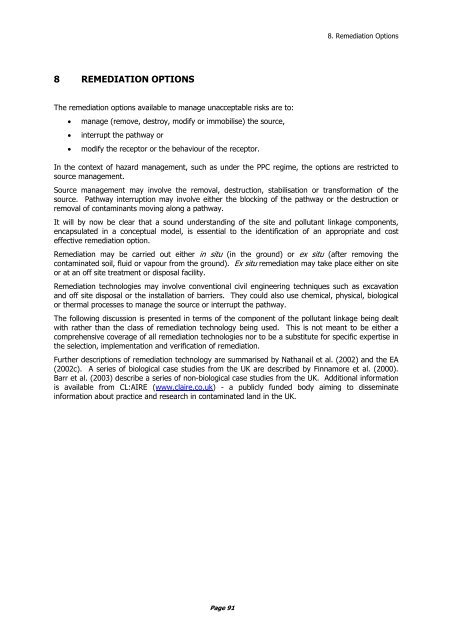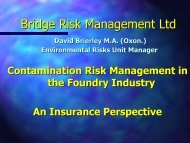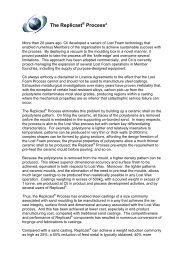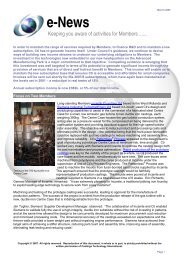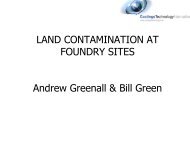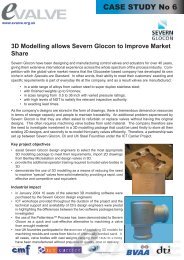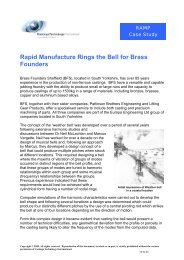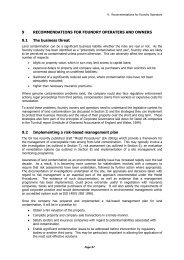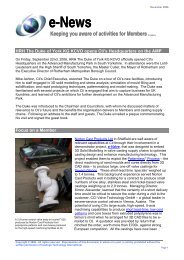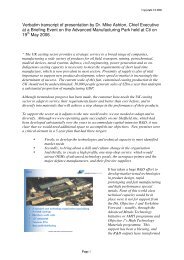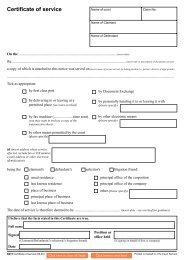8 REMEDIATION OPTIONS - Castings Technology International
8 REMEDIATION OPTIONS - Castings Technology International
8 REMEDIATION OPTIONS - Castings Technology International
You also want an ePaper? Increase the reach of your titles
YUMPU automatically turns print PDFs into web optimized ePapers that Google loves.
8. Remediation Options<br />
8 <strong>REMEDIATION</strong> <strong>OPTIONS</strong><br />
The remediation options available to manage unacceptable risks are to:<br />
• manage (remove, destroy, modify or immobilise) the source,<br />
• interrupt the pathway or<br />
• modify the receptor or the behaviour of the receptor.<br />
In the context of hazard management, such as under the PPC regime, the options are restricted to<br />
source management.<br />
Source management may involve the removal, destruction, stabilisation or transformation of the<br />
source. Pathway interruption may involve either the blocking of the pathway or the destruction or<br />
removal of contaminants moving along a pathway.<br />
It will by now be clear that a sound understanding of the site and pollutant linkage components,<br />
encapsulated in a conceptual model, is essential to the identification of an appropriate and cost<br />
effective remediation option.<br />
Remediation may be carried out either in situ (in the ground) or ex situ (after removing the<br />
contaminated soil, fluid or vapour from the ground). Ex situ remediation may take place either on site<br />
or at an off site treatment or disposal facility.<br />
Remediation technologies may involve conventional civil engineering techniques such as excavation<br />
and off site disposal or the installation of barriers. They could also use chemical, physical, biological<br />
or thermal processes to manage the source or interrupt the pathway.<br />
The following discussion is presented in terms of the component of the pollutant linkage being dealt<br />
with rather than the class of remediation technology being used. This is not meant to be either a<br />
comprehensive coverage of all remediation technologies nor to be a substitute for specific expertise in<br />
the selection, implementation and verification of remediation.<br />
Further descriptions of remediation technology are summarised by Nathanail et al. (2002) and the EA<br />
(2002c). A series of biological case studies from the UK are described by Finnamore et al. (2000).<br />
Barr et al. (2003) describe a series of non-biological case studies from the UK. Additional information<br />
is available from CL:AIRE (www.claire.co.uk) - a publicly funded body aiming to disseminate<br />
information about practice and research in contaminated land in the UK.<br />
Page 91
8. Remediation Options<br />
An overview of remediation options that have been applied in the UK is provided below.<br />
Table 32. A Classification of Some Remediation Options Applied in the UK<br />
<strong>Technology</strong> Class Application Medium<br />
Linkage Element<br />
Affected<br />
Excavation and<br />
off site disposal<br />
Civil Engineering<br />
Ex situ<br />
Soil, Free product,<br />
water, vapour<br />
Source management<br />
Pump and treat Physical Ex situ Free product, Water Source management<br />
Air sparging Physical In situ Water Source management<br />
Soil washing Physical Ex situ Soil Source management<br />
Soil vapour<br />
extraction<br />
Physical In situ Soil – vadose zone Source management<br />
Windrows Biological Ex situ Soil Source management<br />
Biopiles Biological Ex situ Soil Source management<br />
Thermal<br />
desorption<br />
Thermal Ex situ Soil Source management<br />
In situ vitrification Thermal In situ Soil Source management<br />
Incineration Thermal Ex situ Soil, free product Source management<br />
Capping Civil Engineering In situ Soil Pathway interruption<br />
Vertical barriers Civil Engineering In situ<br />
Free product, water,<br />
vapour<br />
Pathway interruption<br />
Bioslurping Biological In situ Water Pathway interruption<br />
Biosparging Biological In situ Water Pathway interruption<br />
In situ oxidation Chemical In situ Soil Pathway interruption<br />
In situ reduction Chemical In situ Soil Pathway interruption<br />
Monitored Natural<br />
Attenuation<br />
Biological,<br />
chemical &<br />
physical<br />
In situ natural<br />
processes<br />
Water<br />
Pathway interruption<br />
Permeable reactive barriers (PRB) are a means of bringing some of the advantages of ex situ<br />
technologies to the in situ domain. They comprise an impermeable barrier (the ‘funnel’) with an<br />
opening (the ‘gate’) that allows contaminated water or vapour to flow through. PRBs operate by<br />
allowing or funnelling contaminated water or vapours to reach the gate and then treating the<br />
contamination while allowing the carrier water or soil air to pass freely through the barrier.<br />
Page 92
8. Remediation Options<br />
8.1 Source management<br />
Remediation targeted at the source of contamination can seek to remove the contaminants, destroy<br />
them, change their chemical form or immobilise them.<br />
8.1.1 Soil<br />
Both heavy metals and organic contaminants can adhere to the soil particles, especially clay and<br />
vegetation components. In situ source management options for contamination in soil include:<br />
• solidification and stabilisation,<br />
• vitrification.<br />
Ex situ methods involve excavation of the contaminated soil or pumping contaminated water or<br />
vapour out of the ground followed by disposal or treatment. Technologies include:<br />
• off site disposal to licensed landfill site,<br />
• encapsulation in an on site engineered cell,<br />
• soil washing and then treatment or disposal of the contaminated residue.<br />
8.1.2 Free product and non aqueous phase liquids<br />
Leaking tanks or spills can result in free product migrating down through the ground. Some products<br />
will dissolve readily in groundwater. Others are not soluble or only sparingly soluble in water – they<br />
are called non-aqueous phase liquids (NAPL). NAPL such as petrol or diesel are lighter than water and<br />
will float on the water table (LNAPL). Chlorinated solvents such as trichloroethene (TCE) are denser<br />
than water and will sink through the ground water to the bottom of an aquifer (DNAPL).<br />
In situ remediation options include monitored natural attenuation (MNA). Natural attenuation has<br />
been observed at the edges of many occurrences of free product. However degradation of the core of<br />
a source area is only very rarely possible. MNA is particularly effective for dissolved phase<br />
hydrocarbons and phenol (in low to moderate concentrations, but ineffective for dissolved chlorinated<br />
solvents. Once contamination has entered the fissures of bedrock it is almost impossible to remove it<br />
all. This makes it difficult to develop ex situ techniques for fractured bedrock.<br />
Ex situ methods include pumping free product and destroying, treating or disposing the recovered<br />
fluids. This can reduce the amount of free product remaining in the ground, but is a slow and<br />
expensive process with variable results.<br />
8.1.3 Vapour/ gas<br />
In situ remediation options are limited, but include soil vapour extraction. Preventing infiltrating water<br />
from reaching waste can slow down the rate of methane production.<br />
Ex situ methods involve recovering the vapour or ground gas followed by capture or destruction.<br />
Technologies include:<br />
• capture via an activated carbon filter,<br />
• thermal desorption from excavated soil,<br />
• destruction by an incinerator.<br />
Page 93
8. Remediation Options<br />
8.2 Pathway Interruption<br />
Once contamination has been released into the ground it can migrate vertically and laterally<br />
contaminating ever-larger volumes of ground. Once contamination reaches the water table, it may<br />
float on top of groundwater, sink through it or either readily or sparingly dissolve in the groundwater.<br />
Preventing the spread of contamination may be an interim solution until the source can be dealt with<br />
or it may be sufficient to render land fit for its current or intended use without removing the source.<br />
Under the PPC regime pathway interruption is unlikely to be acceptable to regulators as a permanent<br />
solution but may be needed to prevent further spread of pollution.<br />
8.2.1 Soil<br />
Receptors can be protected from exposure to contaminants in soil by means of barriers between<br />
source and receptor. Options include:<br />
• capping layer thick enough to stop people coming into contact with contamination,<br />
• vertical barrier keyed into an underlying low permeability soil.<br />
8.2.2 Water (dissolved phase)<br />
In situ remediation options include:<br />
• biostimulation, where natural microbiological processes are accelerated by adding something<br />
for ‘bugs’ to eat and/or to breathe.<br />
• permeable reactive barriers,<br />
• air sparging.<br />
Ex situ methods of treating dissolved phase contaminants are based on conventional waste water and<br />
effluent treatment and include:<br />
• filtration,<br />
• biostimulation,<br />
• pH adjustment.<br />
8.2.3 Vapour/ gas<br />
The distinction between source and pathway for vapour or gas contamination is determined by<br />
concentration and is therefore a blurred one. Vapours may also form part of the pathway by which<br />
volatile liquid contaminants can reach people. In situ remediation options include:<br />
• permeable reactive barriers,<br />
• venting trenches,<br />
• capping,<br />
• vertical barriers,<br />
• gas proof membranes beneath buildings,<br />
• soil vapour extraction.<br />
Page 94
8. Remediation Options<br />
8.3 Receptor Behaviour<br />
The land use will influence who will be at greatest risk. By choosing a less sensitive land use,<br />
contamination may be shown to pose an acceptable level of risk. Examples of restricting receptor<br />
behaviour include prohibiting the growing of vegetables for home consumption.<br />
Security measures such as fencing should not be relied up on to keep out members of the public.<br />
They may however be used to protect an informed workforce.<br />
8.4 Options appraisal<br />
The overwhelming majority of remediation in the UK involves excavation and off site disposal to a<br />
landfill or a surface cap (Nathanail C.P. et al. 2002; Rivett et al. 2002). However changes are arising<br />
from the implementation of the Landfill Directive, the introduction of new technical ‘Model Procedures 1<br />
by the Environment Agency (EA 2003g) and an increasing understanding of the need to protect<br />
groundwater. These will almost certainly promote a shift to more treatment based technologies and a<br />
requirement by regulators for a more transparent documentation of the process by which the<br />
implemented remediation technology has been selected.<br />
The Environment Agency, in their draft ‘Model Procedures’ (EA 2003g), suggest a two stage approach<br />
to remediation options appraisal. The first involves a rapid screening to identify three to four feasible<br />
strategies that are likely to achieve the essential or core objectives of managing the risk followed by<br />
detailed evaluation of these short listed strategies. Finally a remediation strategy is developed that<br />
will demonstrably address all relevant pollutant linkages.<br />
The starting point for options appraisal is the conceptual model of pollutant linkages and a clear<br />
statement of the remediation objectives. There are about 30 generic remediation technologies and<br />
several hundred commercial variants of these. While not all have been applied in the UK, many are<br />
commercially available and should be considered. The core remediation objectives coupled with any<br />
project or site specific constraints (such as space, time available, depth to contamination) should be<br />
used to identify which of these technologies are not appropriate on the site. Each option should be<br />
‘mapped’ onto the conceptual model showing which linkages it is breaking. Only once all the linkages<br />
have been addressed does the technology(ies) constitute a valid remediation option. Generic<br />
information on remediation technologies that may be used to assist in options appraisal is available<br />
from the EA (2002c), US EPA (http://www.clu-in.org/remed1.cfm) and in Nathanail et al. 2002.<br />
8.4.1 Breaking a pollutant linkage<br />
To determine feasible remediation options, you should refer to the conceptual model (see Figure 11 in<br />
Section 5 or Table 27 in Section 7). From that you should establish what the contaminant is (e.g.<br />
arsenic, benzene or trichloroethene), what form it is in (e.g. elemental mercury, hexavalent<br />
chromium, free product, dissolved phase), what its fate and transport properties are (e.g. solubility,<br />
volatility, durability, bioaccumulation potential) and what medium it is present in (e.g. soil, soil air,<br />
groundwater).<br />
Then remediation options can be selected that will deal with the specific form of the contaminant in<br />
the actual medium it is present in. For example soil vapour extraction will remove hydrocarbon<br />
vapours from the unsaturated zone in a sand and gravel soil. However air sparging will remove the<br />
hydrocarbon dissolved in the groundwater deeper in the same sand and gravel. If groundwater is<br />
moving laterally, a permeable reactive barrier can intersect the flow and remove or destroy the<br />
hydrocarbon. Alternatively if there is sufficient travel time before an abstraction borehole is impacted,<br />
monitored natural attenuation may be invoked.<br />
1 The Model Procedures are written from a risk management perspective and relate to breaking the entire<br />
pollutant linkage. This is appropriate to remediation being carried out under the planning system or for Part IIA<br />
purposes. For PPC purposes, the source of any new spills or releases must be dealt with.<br />
Page 95
8. Remediation Options<br />
8.4.2 Breaking several pollutant linkages<br />
Where a conceptual model involves several pollutant linkages, then either a remediation technique<br />
that deals with all of the linkages or a combination of techniques may be needed. If the linkages on a<br />
site are spatially separated and involve different sources and pathways, then separate solutions may<br />
be more likely than where the same source or pathway appears in several linkages.<br />
In any event the aim is to be able to carry out remediation that demonstrably breaks all the pollutant<br />
linkages in the site conceptual model.<br />
Finally it should be borne in mind that the selection and design of remediation options is as much an<br />
art as a science and there is no necessarily optimal solution. However, there will be many sub optimal<br />
or inappropriate options. Selection of a solution without adequate evaluation could result in residual<br />
contamination that still poses an unacceptable risk and future liability for problems in the future.<br />
Page 96


